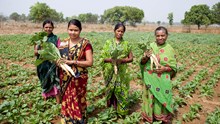
Black Pepper, often hailed as the ‘king of spices,’ is the world's most traded spice, prized for its bold flavor and versatility in cuisines worldwide. Derived from the dried berries, or peppercorns, of the Piper nigrum plant, this spice originates from the Malabar region of southern India. Today, it is cultivated in various countries, including India, Vietnam, Indonesia, Brazil, and Malaysia, playing a key role in global agriculture and offering ample opportunities for innovation and economic development.
Black Pepper Varieties and Hybrids
India grows more than 75 different cultivars of black pepper. All these varieties possess improved characteristics like higher yield, disease resistance, and climatic adaptability. Such cultivars play a significant role in the diversification of pepper production. It enhances resistance against pests and diseases and meets the specific needs of various regions.
Popular local varieties of Kerala include Karimumda, Kimpirian, Kottanadan, and Balankotta. Improved varieties such as Panniyur-1 (Hybrid) from the Kerala Agricultural University (KAU) and Panniyur-2 through clonal selection provide higher yields with better disease resistance. The Indian Institute of Spices Research has developed varieties including Subhakara and Thevam.
Growth Requirements and Propagation
It is a tropical crop that grows between 20° North and South latitudes, from sea level up to 1500 meters above mean sea level (MSL). It grows well in temperatures from 10°C to 40°C with an ideal rainfall of 120-200 cm. The crop requires a pH range of 4.5 to 6.0.
The main means of propagation are cuttings and dry seed as these would guarantee genetic homogeneity and the quickest establishment of plants. This way, the desirable traits from the healthy vines are retained with cuttings. With cuttings from high-yielding vines, there is a minimal delay in plant maturity and fruit production.
Seeds are slower in this regard, they possess a greater level of genetic variation, which means greater adaptability under diverse environmental settings. Primary stem cuttings of support trees like Erythrina sp. Planted with an inter-row spacing of 3 m x 3 m, cuttings are tied to these supports. The young vines are shaded from the strong sun using artificial shade. Normally, standards are lopped regularly to ensure maximum penetration of sunlight and growth.
Fertilization and Manuring
The recommended dosages of NPK for the vines are 50:50:150 grams. The dose will be applied from one-third during the first year, then from two-thirds during the second year, and fully from the third year. Split applications are performed twice; one in May and June and another in August and September of every year using fertilizers.
Organic manures such as cattle manure or compost (10 kg/vine) and neem cake (1 kg/vine) are highly beneficial. Additionally, applying lime (0.5 kg/vine) in alternate years and foliar application of Zinc sulfate (ZnSO4) at 0.25% and Magnesium sulfate (MgSO4) at 150 g/vine for deficient soils is recommended.
Yield and Economic Potential
Dry pepper yield is between 1240 and 2880 kg/ha/year. It is a function of the genotype, soil quality, climatic conditions, and cultural practices. Genotype selection will influence the potential yield, and soil fertility and proper nutrient management help to achieve optimized growth.
The adoption of best practices in planting, pruning, and pest control can maximize yield and ensure consistent quality. The market price averages around Rs. 64,000 per quintal which makes it a profitable venture for farmers.
Pest and Disease Management
Black pepper cultivation requires effective management of pests and diseases to sustain the crop. Organic pesticides, frequent monitoring, and bio-control agents like Trichoderma and Pseudomonas fluorescens have proven to be effective. Crop rotation and maintaining hygiene in the fields also help in reducing the occurrence of diseases.
For pest control, pheromone traps and natural predators are widely used to manage the population sustainably. Common pests involve the Pollu beetle (Longitarsus nigripennis), the Top shoot borer (Cydia hemidoxa), and the Leaf gall thrips (Liothrips Karnyi). Planting must be supplemented with integrated pest and disease management techniques to remain healthy.
For farmers, black pepper is a symbol of agricultural innovation and financial success. Farmers can boost output and profitability through improved cultivars, effective cultivation methods, and sustainable pest management strategies. In addition to enhancing international cuisines, this ‘king of spices’ offers the farming community hope and opportunity.
















